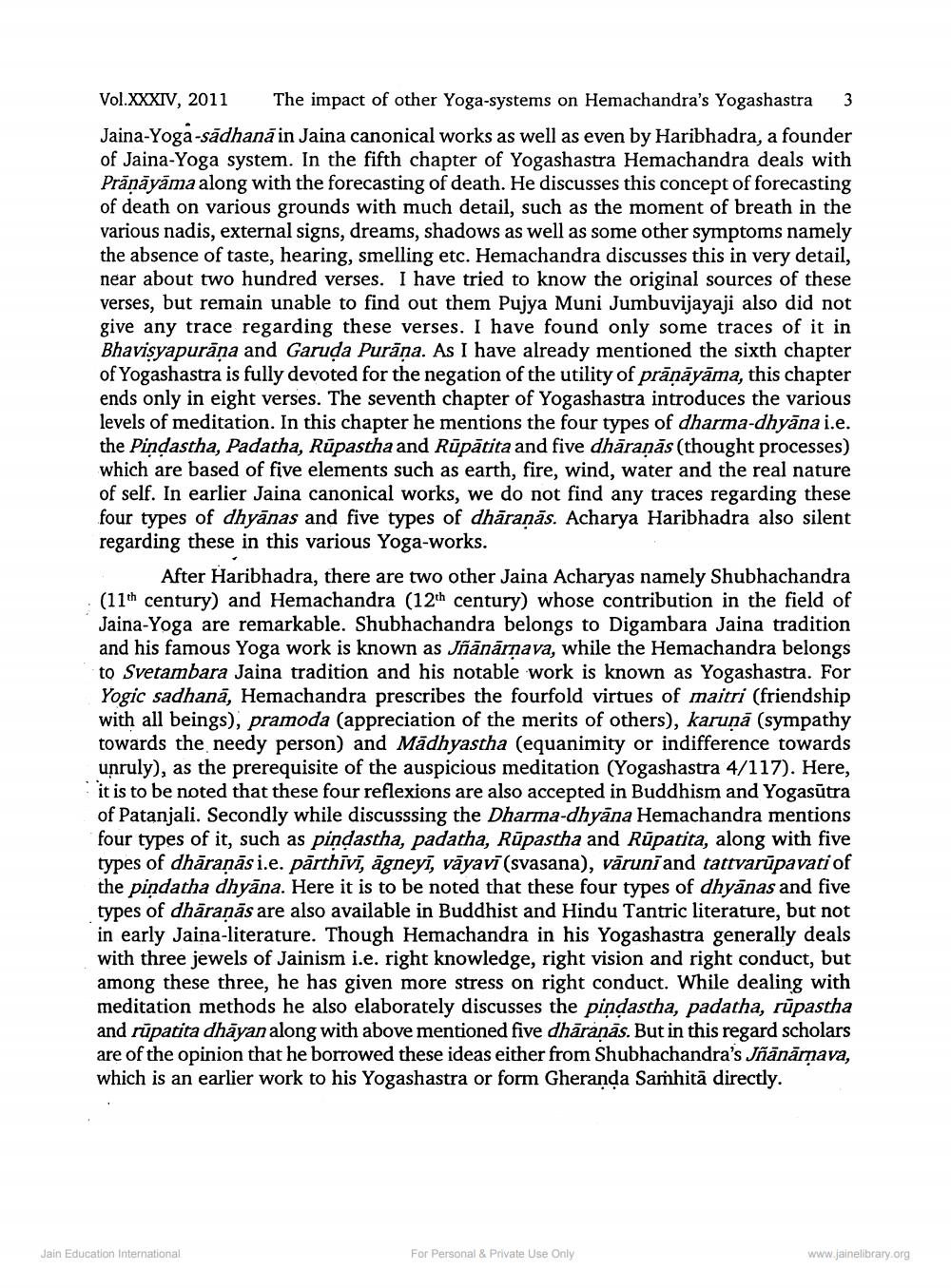Book Title: Sambodhi 2011 Vol 34 Author(s): Jitendra B Shah Publisher: L D Indology Ahmedabad View full book textPage 9
________________ Vol.XXXIV, 2011 The impact of other Yoga-systems on Hemachandra's Yogashastra 3 Jaina-Yoga-sādhanā in Jaina canonical works as well as even by Haribhadra, a founder of Jaina-Yoga system. In the fifth chapter of Yogashastra Hemachandra deals with Prānāyāma along with the forecasting of death. He discusses this concept of forecasting of death on various grounds with much detail, such as the moment of breath in the various nadis, external signs, dreams, shadows as well as some other symptoms namely the absence of taste, hearing, smelling etc. Hemachandra discusses this in very detail, near about two hundred verses. I have tried to know the original sources of these verses, but remain unable to find out them Pujya Muni Jumbuvijayaji also did not give any trace regarding these verses. I have found only some traces of it in Bhavisyapurana and Garuda Purāna. As I have already mentioned the sixth chapter of Yogashastra is fully devoted for the negation of the utility of prānāyāma, this chapter ends only in eight verses. The seventh chapter of Yogashastra introduces the various levels of meditation. In this chapter he mentions the four types of dharma-dhyāna i.e. the Pindastha, Padatha, Rupastha and Rūpātita and five dhāranās (thought processes) which are based of five elements such as earth, fire, wind, water and the real nature of self. In earlier Jaina canonical works, we do not find any traces regarding these four types of dhyānas and five types of dhāranās. Acharya Haribhadra also silent regarding these in this various Yoga-works. After Haribhadra, there are two other Jaina Acharyas namely Shubhachandra (11th century) and Hemachandra (12th century) whose contribution in the field of Jaina-Yoga are remarkable. Shubhachandra belongs to Digambara Jaina tradition and his famous Yoga work is known as Jñānārnava, while the Hemachandra belongs to Svetambara Jaina tradition and his notable work is known as Yogashastra. For Yogic sadhanā, Hemachandra prescribes the fourfold virtues of maitri (friendship with all beings), pramoda (appreciation of the merits of others), karunā (sympathy towards the needy person) and Madhyastha (equanimity or indifference towards unruly), as the prerequisite of the auspicious meditation (Yogashastra 4/117). Here, it is to be noted that these four reflexions are also accepted in Buddhism and Yogasūtra of Patanjali. Secondly while discusssing the Dharma-dhyāna Hemachandra mentions four types of it, such as pindastha, padatha, Rūpastha and Rūpatita, along with five types of dhāranās i.e. pārthīvi, āgneyi, vāyavi (svasana), vārunī and tattvarūpavati of the pindatha dhyāna. Here it is to be noted that these four types of dhyānas and five types of dhāranās are also available in Buddhist and Hindu Tantric literature, but not in early Jaina-literature. Though Hemachandra in his Yogashastra generally deals with three jewels of Jainism i.e. right knowledge, right vision and right conduct, but among these three, he has given more stress on right conduct. While dealing with meditation methods he also elaborately discusses the pindastha, padatha, rūpastha and rūpatita dhāyan along with above mentioned five dhāranās. But in this regard scholars are of the opinion that he borrowed these ideas either from Shubhachandra's Iñānārņava, which is an earlier work to his Yogashastra or form Gheranda Samhită directly. Jain Education International For Personal & Private Use Only www.jainelibrary.orgPage Navigation
1 ... 7 8 9 10 11 12 13 14 15 16 17 18 19 20 21 22 23 24 25 26 27 28 29 30 31 32 33 34 35 36 37 38 39 40 41 42 43 44 45 46 47 48 49 50 51 52 53 54 55 56 57 58 59 60 61 62 63 64 65 66 67 68 69 70 71 72 73 74 75 76 77 78 79 80 81 82 83 84 85 86 87 88 89 90 91 92 ... 152
